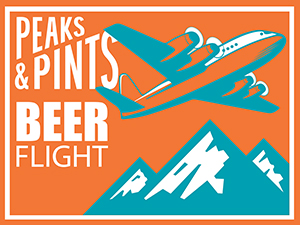 Scottish style beers can be a malt lover’s dream beer, with its smooth sweetness and body. The epitome of malty, scotch ales is boiled twice as long as ordinary beer, caramelizing the sugars to build these deep flavors of maple and molasses. Recipes may include peat-smoked malt, which can lend smoky, earthy tones to the aroma and flavor. Scottish ales commonly fall into four general types: Light, Heavy, Export and the Scotch Ale. Historically these distinctions carried labels of the shilling currency, which reflected the price charged per barrel of beer in the 19th century. For example, 60 shilling was used for Light Scottish Ales, 70 shilling for Heavy, 80 shilling for Export and above 90 shilling for Scotch Ale and Wee Heavy. The Scotch Ale, compared to other Scottish Ales, offers richer color, more malty sweetness and higher alcohol that can range from 6-8 percent ABV. Wait, what? There’s a difference between Scottish and Scotch ales? There certainly is. Mainly, Scottish ales are ales brewed in Scotland or in the Scottish style. Scotch ales are US and Belgian interpretations of the Scottish style strong dark ale. Today’s Peaks and Pints to-go beer flight features both, a flight we call Peaks and Pints Pilot Program: Scotch On The Fly.
Scottish style beers can be a malt lover’s dream beer, with its smooth sweetness and body. The epitome of malty, scotch ales is boiled twice as long as ordinary beer, caramelizing the sugars to build these deep flavors of maple and molasses. Recipes may include peat-smoked malt, which can lend smoky, earthy tones to the aroma and flavor. Scottish ales commonly fall into four general types: Light, Heavy, Export and the Scotch Ale. Historically these distinctions carried labels of the shilling currency, which reflected the price charged per barrel of beer in the 19th century. For example, 60 shilling was used for Light Scottish Ales, 70 shilling for Heavy, 80 shilling for Export and above 90 shilling for Scotch Ale and Wee Heavy. The Scotch Ale, compared to other Scottish Ales, offers richer color, more malty sweetness and higher alcohol that can range from 6-8 percent ABV. Wait, what? There’s a difference between Scottish and Scotch ales? There certainly is. Mainly, Scottish ales are ales brewed in Scotland or in the Scottish style. Scotch ales are US and Belgian interpretations of the Scottish style strong dark ale. Today’s Peaks and Pints to-go beer flight features both, a flight we call Peaks and Pints Pilot Program: Scotch On The Fly.
Peaks and Pints Pilot Program: Scotch On The Fly
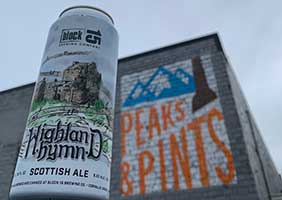 Block 15 Highland Hymn
Block 15 Highland Hymn
6.5% ABV, 18 IBU
Highland Hymn is designed and brewed in cooperation with former Block 15 brewer Sydney Lee. She found inspiration by the majestic sights and sounds of Scotland. Her Highland Hymn is a crescendo of caramelized sugar and toffee notes accompanied by a pleasant dry finish. Brewed with a duet of imported Scottish barley and beechwood smoked rauch malt, this malt-forward ale is as wonderfully complex and robust as the Scottish Highlands.
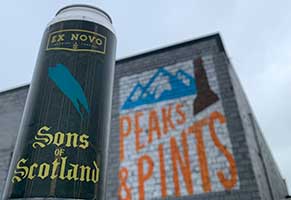 Ex Novo Sons of Scotland
Ex Novo Sons of Scotland
7.6% ABV, 24 IBU
Ex Novo Brewing’s Sons of Scotland sees a variety of North American, English and German malts and a touch of hops for balance in the brewing process. On the nose, expect freshly baked brown bread, peat-smoked barley, toffee, and earthiness. A huge bombardment of brown bread, smoked peat, toffee, and earthiness also arrive on the tongue, but are joined by rich toffee and some dried dark fruit notes. It’s a smooth drinker.
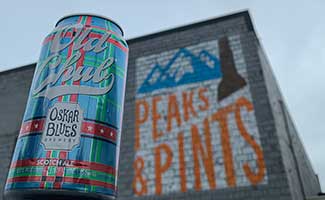 Oskar Blues Old Chub
Oskar Blues Old Chub
8% ABV, 25 IBU
Old Chub is a Scottish style ale brewed with copious amounts of crystal and chocolate malts, a dash of beechwood-smoked malts and Nugget hops. While Oskar Blues’ Dale’s Pale Ale is a showcase of both hops and pale malts, Old Chub is a celebration of malts. The cola-colored beer features a dense, tawny head, a creamy mouthful and flavors of caramel, chocolate and lightly roasted malt. Complex and rich, it finishes with a whisper of smokiness that calls to mind a fine single malt scotch.
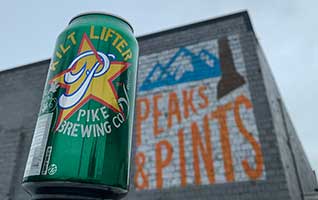 Pike Kilt Lifter Scotch Style Ruby Ale
Pike Kilt Lifter Scotch Style Ruby Ale
6.5% ABV, 27 IBU
Pike Brewing‘s heavy Scotch ale is lightly hopped with a strong malt character, and a subtle underlying smokiness from the addition of a small amount of peated Scotch whisky malt, which adds complexity. Warm fermentation produces fruity esters and balances the sweet malt character, as well as oaky vanilla and light tobacco. Layers of rich, sweet, powerful earthy malt — like freshly baked bread — makes Kilt Lifter great by itself or with food.
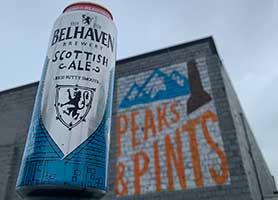 Belhaven Scottish Ale
Belhaven Scottish Ale
5.2% ABV, 28 IBU
John Johnstone founded Belhaven Brewery in Dunbar in 1719. Belhaven means “beautiful bay,” named after the stunning coastal location in East Lothian on which it resides. The home of Scottish brewing, Belhaven brews with local Scottish barley, water from its brewery well, its own unique Belhaven yeast and the choicest of hops from around the world. Belhaven’s Scottish Ale is a solid beer with a nutty, sweet flavor and a touch of oak in the aroma. Because the can has a nitrogen widget, this scotch ale has an extraordinary long-lasting head, which also gives it a very smooth and rounded mouthfeel.
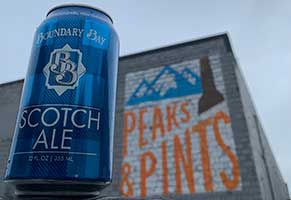 Boundary Bay Scotch Ale
Boundary Bay Scotch Ale
6.4% ABV, 31 IBU
Boundary Bay Brewery & Bistro is the oldest craft brewery in Bellingham. It is the creation of Ed Bennett, a University of Washington alum who went on to earn his Master’s degree in winemaking from UC Davis before landing in another small college town, Bellingham, to begin exploring his new love, beer. In 1994, he signed the lease for the Thomas Burns building at 1107 Railroad Ave. to begin building Boundary Bay Brewery. His Scotch Ale became a Northwest classic with the inaugural brew in 1995. The long boil in the kettle caramelizes the wort, producing deep-copper tones. Scotch Ale hits the nose with caramel and biscuit, which is also the flavor profile with added light spiciness, oak notes and a touch of fruit.
